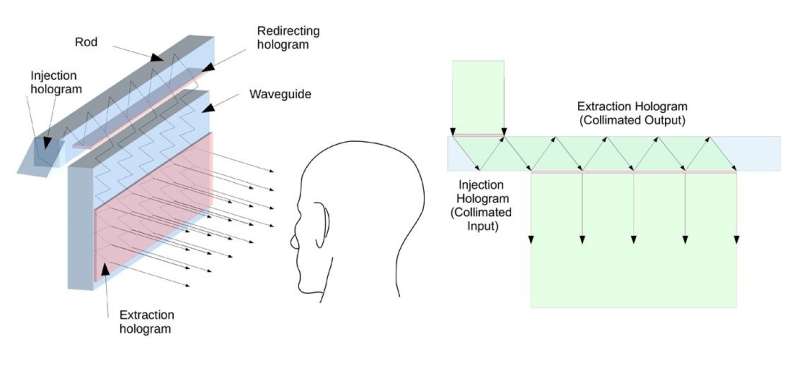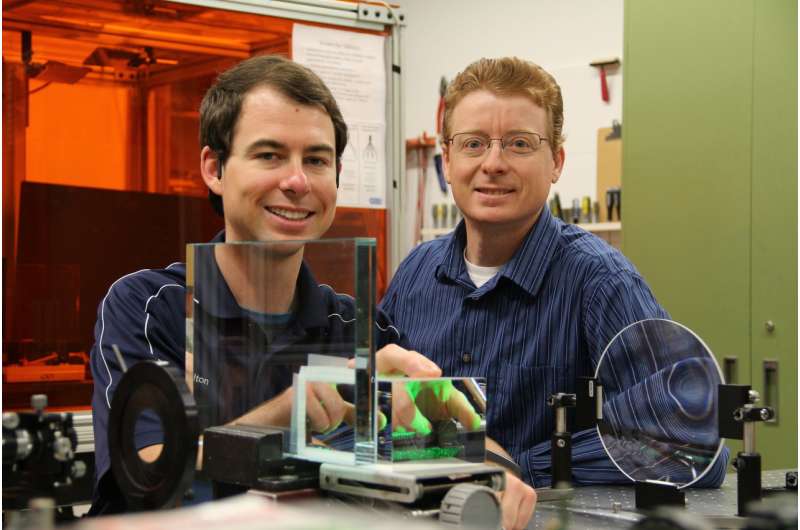The new heads-up display uses holographic optical elements to inject an image into the glass, or waveguide (left). The light enters the glass and bounces back and forth between its front and back edges until it reaches another holographic optical element that extracts a small portion of light that leaves the glass with each bounce (right). The extraction holographic creates a viewable image, with each bounce proportionally increasing the eye box size for the image. Credit: Pierre-Alexandre Blanche, University of Arizona
Heads-up displays are transparent devices used in airplanes and cars to provide information such as critical flight data or driving directions on the windshield. An innovative holography-based approach could soon make these heads-up displays much easier to see with a large eye box.
Current heads-up displays have a small eye box, meaning that the displayed information partially or wholly disappears if users shift their gaze too much. "A heads-up display using our new technology installed in a car would allow a driver to see the displayed information even if he or she moved around or was shorter or taller than average," said research team leader Pierre-Alexandre Blanche of the University of Arizona, USA.
In The Optical Society journal Applied Optics, the researchers demonstrate a functional prototype heads-up display that uses holographic optical elements to achieve an eye box substantially larger than what is available without the holographic element. The researchers say that their approach could be turned into a commercial product in as little as a few years and might also be used to increase the size of the displayed area.
"Increasing the size of either the eye box or the displayed image in a traditional heads-up display requires increasing the size of the projection optics, relay lenses and all the associated optics, which takes up too much space in the dashboard," said first author Colton Bigler, a doctoral student in Blanche's laboratory. "Instead of relying on conventional optics, we use holography to create a thin optical element that can be ultimately applied onto a windshield directly."
The researchers built a prototype and showed that it could display flight information on a piece of glass representing a windshield. The image in the background is displayed on a television located 10 meters behind the heads-up display system. The beginning of the video shows that the presented image appears in the far field, meaning that observers don't need to change their focus to see the displayed information. The larger eye box of the display is evident when the camera view moves but the displayed information remains visible until the view moves far off to the side. Credit: Pierre-Alexandre Blanche, University of Arizona
Using holograms to make optics
The same laser light interactions used to create the holograms that protect credit cards from forgery can also be used to fabricate optical elements such as lenses and filters in light-sensitive materials. These holographic elements are not only smaller than traditional optical components but can be mass produced because they are easily fabricated.
For the new head-up display, holographic optical elements redirect light from a small image into a piece of glass, where it is confined until it reaches another holographic optical element that extracts the light. The extraction hologram presents a viewable image with a larger eye box size than the original image.
"We are working with Honeywell to develop these displays for aircraft, but they could just as easily be used in cars," Blanche said. "Our approach requires no expensive equipment and no new materials need to be developed. Furthermore, the display can be completely integrated into a standard car windshield."
After performing optical simulations, the researchers created a laboratory version of their head-up display that created an eye box seven times larger than the original image. They then made a working prototype that displayed flight information on a piece of glass that can be part of the transparent enclosure that covers cockpits. Using the prototype, they were able to almost double the eye box of the original image and showed that the image doesn't disappear until the user looks beyond the edge of the hologram. They also demonstrated that the presented image appears in the far field, meaning that observers don't need to change their focus to see the displayed information.
Colton Bigler and Pierre-Alexandre Blanche used holography to improve heads-up displays that overlay images onto the windshields of cars and airplanes. Shown here is the laboratory version of their system. Credit: Pierre-Alexandre Blanche, University of Arizona
"It's possible to create a much larger eye box by increasing the size of the injection and extraction holographic elements, the only limitation is the size of the glass displaying the image," Blanche continued. "Our work is a good example of how holography can be used to solve many types of optical problems for various applications. A similar approach might also be useful for augmented reality headsets, which also merge computer-generated images with views of the outside world but with a display that is close to the eye."
Although the researchers demonstrated their approach using one color, they say that it could be expanded to create full-color heads-up displays. They are also working to use the same approach to create a much larger image that is extracted by the holographic element to increase the size, or field of view, of the display.
More information: Colton M. Bigler et al, Holographic waveguide heads-up display for longitudinal image magnification and pupil expansion, Applied Optics (2018). DOI: 10.1364/AO.57.002007
Provided by Optical Society of America























